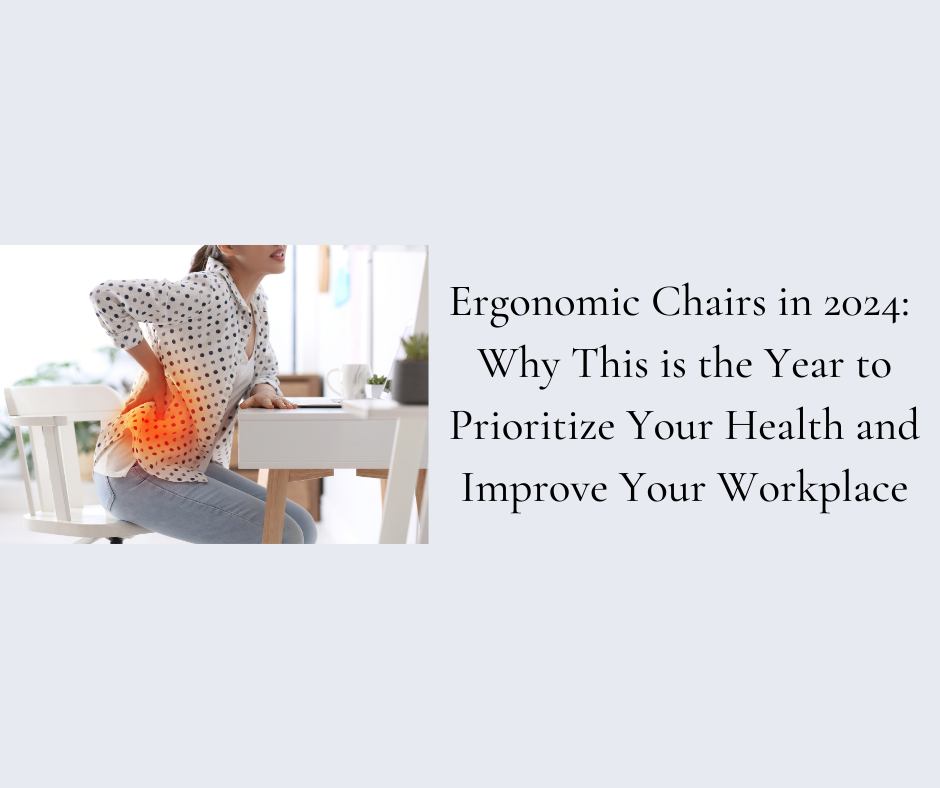
Ergonomic Chairs in 2024: Why This is the Year to Prioritize Your Health and Improve Your Workplace
Introduction: A Tale of Two Sitters
Picture two professionals, Alex and Jordan, who work demanding office jobs. Alex, slouched in a standard office chair, often complains about backaches and fatigue. Jordan, on the other hand, can make it through the workday more comfortably in an ergonomic chair without the burden of poor posture. This tale of two sitters isn't uncommon in many office places. Don't be like Alex. 2024 is the year to prioritize your health and improve your workspace for greater comfort and productivity!
Background & Context: The Rising Tide of Ergonomic Awareness
In recent years, particularly since the onset of the COVID-19 pandemic, ergonomics has taken center stage in workplace health and productivity discussions. Historically, ergonomics has been a crucial aspect of workplace design, but its significance has skyrocketed in the new era of remote work and increased digital interaction.
A pivotal study conducted during the pandemic sheds light on this growing concern. According to a 2022 research article in the journal Sport Sciences for Health, titled "The relationship between objectively measured sitting time, posture, and low back pain in sedentary employees during COVID-19," a significant shift has occurred in our work habits (1). The study involved 53 full-time employees in sedentary roles and aimed to assess the impact of prolonged sitting on posture and lower back pain.
The findings are startling and relevant to millions adapting to remote work:
- The transition to home offices has led to an alarming increase in sitting time, with those working from home sitting significantly more than their office-based counterparts.
- This increased sitting time has been linked to poor hip posture, a precursor to chronic lower back pain.
- Despite the common misconception, the study found that sitting time alone wasn't a direct predictor of lower back pain. However, the combination of prolonged sitting and poor ergonomic setups at home raises a red flag for potential health issues.
As we delve deeper into this topic, consider this: How has your work environment changed since the pandemic? Are you experiencing discomfort or pain that wasn't there before? The insights from this study are not just academic; they reflect a widespread shift in our work lives that could have long-term health implications.
The Problem: The Ergonomic Deficit in Modern Workplaces
Despite the known benefits of ergonomic furniture, many modern workplaces still hesitate to embrace these solutions. The reluctance to invest in employee health often stems from perceived high costs and lack of recognition by employers of its long-term value. Employers who ignore the value and significance of ergonomics place employees in danger of developing musculoskeletal disorders, a noticeable dip in productivity, and potential deterioration in mental health.
The Solution: Embracing Ergonomic Chairs
Integrating ergonomic furniture, particularly chairs, into the workplace is the solution. Here's why:
- Improved Physical Health: Ergonomic chairs support the spine's natural curve, reducing the risk of back pain and other musculoskeletal problems.
- Enhanced Productivity: Comfortable seating means fewer distractions and more focus, leading to increased productivity.
- Boosted Mental Wellbeing: A comfortable work environment positively impacts mental health, reducing stress and improving overall job satisfaction.
Case Study: The Ergonomic Transformation at Steelcase
Introduction
In the realm of ergonomic innovation, Steelcase stands as a beacon, showcasing how a company can revolutionize its workspace to enhance employee satisfaction and health. Their journey, detailed in the article "Building Wellbeing into the Workplace," serves as an inspiring case study for businesses aiming to foster a healthier, more productive work environment (2).
Background
Steelcase, renowned for its cutting-edge office designs, embarked on a mission to embed wellbeing into the very fabric of its workplace culture. This initiative wasn't just about creating comfortable chairs; it was a comprehensive strategy to improve the overall quality of work life for their employees.
The Ergonomic Intervention
At the heart of Steelcase's transformation was the introduction of ergonomic chairs designed to meet diverse needs. Recognizing that one size does not fit all, Steelcase developed seating solutions that catered to various body sizes and working postures. This move was pivotal in addressing the physical aspect of employee wellbeing.
A Holistic Approach
Steelcase's strategy extended beyond the physical comforts of ergonomic seating. They adopted a holistic approach, considering the mental and emotional wellbeing of their employees. This encompassed creating spaces that not only supported physical health but also fostered a sense of mental and emotional balance.
Measurable Outcomes
The results of Steelcase's ergonomic transformation were nothing short of remarkable. The company witnessed substantial cost savings, a reduction in health insurance premiums, and a decrease in absenteeism and medical claims. These tangible benefits were clear indicators of the strategy's success.
Conclusion
Steelcase's case study is a testament to the power of ergonomic seating and a holistic approach to workplace wellbeing. Their success story highlights how such initiatives can significantly improve employee health, satisfaction, and overall organizational performance. This example serves as a valuable model for other companies looking to make a similar transformative journey toward a healthier, more productive workplace.
Conclusion: Making the Ergonomic Shift
2024 is the year to prioritize your health and wellness in the workplace. Here are three actionable takeaways:
- Assess Your Seating: Evaluate your current office chair. Does it support your back and promote good posture?
- Research Ergonomic Options: Look into ergonomic chairs that fit your body type and work style.
- Advocate for Workplace Wellness: Encourage your workplace/employer to invest in ergonomic furniture.
Ergonomic chairs are not just a trend but a necessity in the modern workplace. By making the shift, you can look forward to a healthier, more productive work environment.
References:
- Butte, K. T., Cannavan, D., Hossler, J., Travis, C., & Geiger, J. (2023). The relationship between objectively measured sitting time, posture, and low back pain in sedentary employees during COVID-19. Sport Sciences for Health, 19(1), 259-266. https://doi.org/10.1007/s11332-022-01031-x
- Steelcase, "Building Wellbeing into the Workplace".
